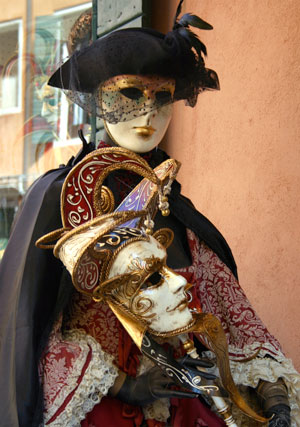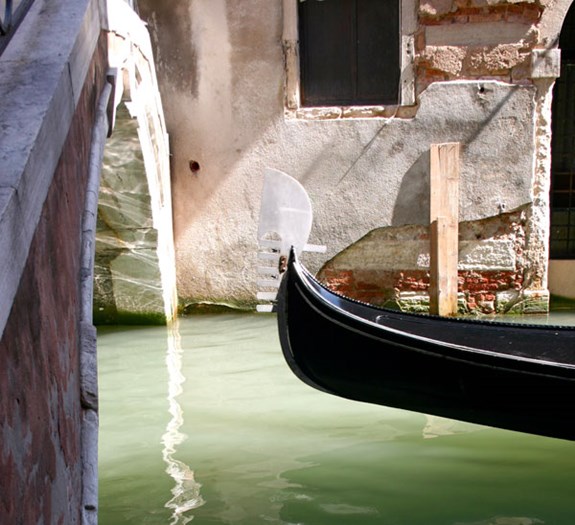VENICE - It was in a small shop on a narrow back street of this water-logged city that I had my first encounter with a Merchant of Venice.
Boldini Venezia glanced up from her work table and bid me “bon journo” as I entered her small mask shop called La Bottega dei Mascareri at the foot of the Rialto Bridge on San Polo St.
She was lovingly putting the final touches on another of her legendary paper mache masks and asked for my patience as she finished the work of art.
I wandered about the small shop she opened in 1984 and where she continues the tradition her family, the Boldrins, started centuries earlier.
Hundreds of faces looked down on me from the shop’s dark walls. Some were sad. Others were happy. All were beautiful.
“Can I help you?” asked the charming Boldini.

Above: Masks are a Venetian trademark.
I told her I was under strict orders not to return home without a Venetian mask. And a hotel concierge had told me that masks made in the Boldrin tradition were the best ones to buy.
“The concierge must be a cousin,” said the woman with the laughing eyes. “Come, I will show you what I have recently completed.”
I followed Boldini to her work area, which looked more like an artist’s studio.
“We make the masks by hand and then paint them. The masks sold in St. Mark’s Square are often imported. Imagine! A mask being sold in Venice that wasn’t made here.”
Historians say they’ve been making masks in Venice since 1436 but Boldini said she has evidence the craft actually started here in 1268.
There are many variations offered by Viennese mask makers, according to Boldini, but the favorites are the beautiful Bauta cast, preferred by Venetian nobility, and the Moretta, a small oval mask worn by women of all social classes back in ancient times. The shop also featured 18th century masks worn to classic Italian operas and ones used by court jesters. There’s even an impressive cast of Vincent van Gogh hanging in the shop.
The mask industry is as important to Venice’s economy as tourism, glass blowing and gondolas. And business has been good for Boldini in recent years. So good, she recently opened a second shop at 2720 San Polo in the city’s charming working class Campo San Polo district.
The walls of her studio are lined with favorable articles from the New York Times and other international publications, each writer praising Boldini for her ability to give masks a personality.
One of her beautiful creations drew my attention and Boldini took notice.
“She is beautiful, no?” said the woman with grey streaks running through her hair. “Is she the one you will take home?”

Above: The back streets and canals are where you'll find the best shops.
Forgetting to even ask the price, I said “yes” and Boldini began wrapping the mask with the Mona Lisa smile. I stopped her and asked if she’d sign the mask.
"Of course,” she said. “I will even put my name on the bill.”
The mask cost much less than I expected – just under $100. But Boldini threw in some free advice that ended up saving me hundreds of dollars more later in the day.
“Forget about eating in St. Mark’s. Everything there is overpriced. Here, in Campo San Polo, you will find local restaurants that serve good meals for half what those robbers in St. Mark’s charge.”
Campo San Polo is a compact district on the opposite side of the Grand Canal from St. Mark’s square. It’s a labyrinth of small streets where few tourists venture. They don’t know what they’re missing.
This is the real Venice - where laundry hangs from shuttered terra cotta buildings; where people move furniture on trolleys; where shopkeepers sell delicious-looking meats and cheeses and wonderful smelling breads to clients they all seem to know by first names; and where mothers scream and make dramatic gestures at their wide eyed children.
San Polo even has its own version of St. Mark’s Square – it’s called St. Maria dei Frari, a church that dates back to the 13th century and holds many historical treasures.
I thanked Boldini for her advice, began to leave her shop, and said the money she saved me would be used for a romantic gondola ride later. The woman charged into the street and scolded me.
“You tourists are so eager to give away your money. They (the gondoliers) will charge you $120 for a short ride. And they don’t even sing well.
“No, if you want a gondola ride, and then take the traghetto across the Grand Canal,” ordered Boldini. “It will cost only $3.”
Gondolas are the descendants of the traghetto, a holdover from the 17th century that acted as a water taxi back then. There are just a few traghettos still in service – mostly along the Grand Canal. They are mainly used by locals to get to work. The ride in a traghetto lasts just a few minutes and while not as romantic as a gondola, it does give tourists a cheap thrill.
Traghettos don’t come all decked out with a silver dragon bow or golden ornaments like the canal gondolas and it has no seats, just a couple of narrow rails running along each side where you rest your bottom.
If you’d pay the oarsman a few extra euro, he might even break into a few bars of O Sole Mio. The one that crosses the canal to San Polo can be boarded near the world-famous Rialto Bridge.
Unmasking Venice can be fun, if you get the right directions.
Information
- For information on the La Bottega dei Mascareri mask shops contact them by e-mail at mascarer@tin.it
- There are several other ways to see Venice from the water without having to pay the high prices the gondoliers charge – especially if you are traveling alone – including buying a 24-hour water bus pass that takes you around the aquatic city and to some of the neighboring islands for just 10.50 euros. There’s also passes covering one-day and 72-hour periods.
- The water buses do not go down the narrow canals but the water taxis do - but they charge almost as much as the gondoliers.
About the Author
Marc Atchison is a veteran journalist and a seasoned traveller with more than 20 years of travel writing experience. As the former Travel Editor of the Toronto Star, Canada's largest newspaper, and now Editor-in-Chief and Senior Writer for TraveLife magazine (Canada) and travelife.ca, Marc has been to over 100 countries in the world. Japan is one of his favorite destinations and he's been there on numerous occasions.